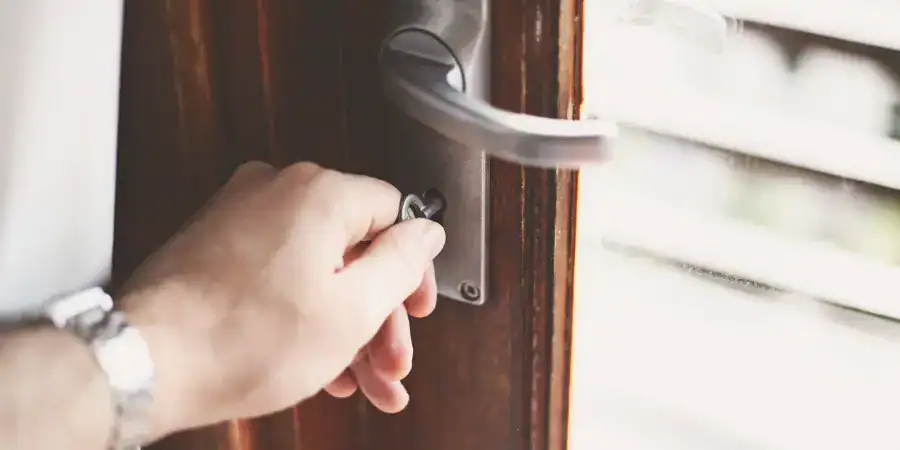Ever been stuck outside with a sticky lock? Maybe it’s raining, your hands are full of groceries, and the key won’t turn. Whether it’s your front door, mailbox, or garden gate, sticky locks can be a real headache.
This guide offers easy DIY ways to get your locks moving smoothly again and explains when to call a professional locksmith.
Why Locks Stick
Even in Southern California’s mild climate, locks face a few challenges:
- Dust and debris – Frequent winds carry fine particles that settle in the lock cylinder. Combined with old lubricant, they form a gritty paste that blocks smooth movement.
- Weather changes – Slight temperature shifts cause metal to expand and contract, making locks tighter or more difficult to turn.
- Age and wear – Springs weaken, pins wear down, and tolerances loosen. Most household locks start showing issues after 5–7 years.
What You’ll Need
Before starting, grab these basics:
- Graphite lubricant (powder or spray)
- Compressed/canned air
- Small screwdriver set
- Needle-nose pliers
- Wire brush or toothbrush
Most items are inexpensive and easy to find at any hardware store.
Step-by-Step DIY Fixes
1. Clear Out Dirt & Dust
- Insert the key halfway, wiggle it, then pull it out to dislodge debris.
- Spray compressed air into the lock with short bursts, keeping the can upright.
- Use a small brush to gently clean around the keyway opening.
2. Lubricate the Lock
- Apply graphite lubricant—never oil-based sprays like WD-40, which attract dust.
- Insert the tube into the keyway, give a short spray, then work the key in and out 10–15 times.
- In a pinch, rub a soft pencil on your key and insert it; the graphite will transfer inside.
3. Check for Alignment Problems
If the key slides in but won’t turn easily:
- Lift the door handle slightly while turning the key.
- If this helps, the strike plate or hinges may need adjustment.
4. Tackle Temperature Issues
- Warm the key with water before inserting—it can help with metal contraction.
- For recurring problems, a locksmith can slightly adjust the cylinder.
Advanced Fixes (If You’re Handy)
- Disassembling the lock – Remove the lock (usually two screws on the inside) and clean the cylinder thoroughly. Take photos as you go for easy reassembly.
- Replacing internal parts – Springs and pins can wear out. These parts can be replaced, but installing a new lock is usually cheaper and faster unless the lock is expensive or sentimental.
When to Call a Locksmith
DIY works for most cases, but call a pro if:
- The key turns freely without engaging the bolt (security risk).
- A key breaks inside the lock.
- Problems return soon after a DIY fix.
- You’re dealing with smart locks, high-security cylinders, or electronic systems.
- You’re locked out in an emergency—24/7 locksmiths are available across Southern California.
Preventive Care Tips
- Quarterly cleaning – A quick spray of compressed air + graphite keeps locks clear.
- Annual inspection – Check for loose screws, worn keys, or alignment issues.
- Use light keychains only – Heavy ones wear down internal parts.
- Replace old keys – Worn teeth can damage cylinders.
Cost Guide
- DIY repairs: $5–15 in materials, 15–30 minutes of time.
- Professional service calls: $75–150 on average.
- Emergency service: Higher, but worth it if you’re locked out.
Final Thoughts
Most sticky locks can be fixed with simple cleaning and graphite lubrication. If problems persist or security is at risk, call a locksmith. After all, your locks are the first line of defense for your home—and keeping them in top shape ensures both convenience and safety.
FAQs: Fixing Sticky Locks
Q: How often should I lubricate my locks?
Every 3–4 months in dusty conditions, or twice yearly indoors.
Q: Can I use household oils?
No — stay with graphite. Oils attract dirt and gum up locks.
Q: Why does my key only work sometimes?
This is usually caused by worn keys, internal wear, or temperature changes. Try graphite first.
Q: Should I repair or replace my lock?
Locks under 5 years are often worth fixing. Older or repeatedly failing locks are better replaced.
Q: How long do locks last?
With regular maintenance, a high-usage lock typically lasts about 5 to 7 years in coastal areas.
